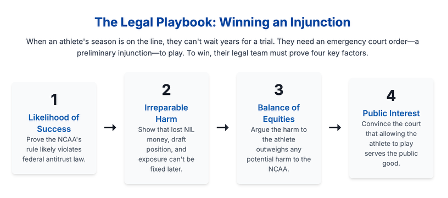🏛 THE NEW PLAYING FIELD | How college athletes took the NCAA to court and fundamentally rewrote the rules of college sports.
SUMMARY: College and high-school athletes are increasingly turning to the courts to challenge NCAA rules and secure their rights to play and profit from their talent, thanks to new NIL regulations. Recent victories, like those in Ohio and the Pavia case, show courts are crucial in changing the landscape of amateur sports, even though outcomes remain unpredictable. Today, the law is actively shaping the future of athletics at every level.
Today’s college athletes are not just competing for positions on the field—they’re also fighting for their fundamental right to play. In the wake of new rules concerning Name, Image, and Likeness (NIL), transfer portals, and revenue sharing, athletes increasingly find themselves heading to the courtroom - instead of to the court - seeking judicial intervention to challenge NCAA eligibility and transfer restrictions.
The Role of Injunctions in Athlete Lawsuits
When an athlete sues the NCAA, they often do not have time to wait for a full trial. A season is short, and eligibility windows close quickly – so to stay on the field during ongoing legal battles, many athletes request injunctions—temporary court orders that allow them to participate while their cases are resolved. These injunctions are not permanent solutions, but they are crucial lifelines, keeping careers alive as the legal process unfolds; basically, without them, their careers could be over before the case ever finishes.
The Four Hurdles to Winning an Injunction
Athletes seeking these emergency court orders must clear four primary legal hurdles:
Likelihood of Success: The athlete must show a strong chance of winning the case at trial.
Irreparable Harm: They need to demonstrate that being unable to play would cause harm that cannot be fixed by money alone—such as lost playing time, exposure, or NIL opportunities.
Balance of Equities: The court weighs whether the harm to the athlete from being sidelined is greater than any harm to the NCAA if the injunction is granted.
Public Interest: The athlete must argue that letting them play aligns with broader public interests, such as fairness or the integrity of competition.
Recent Court Decisions Shape the Landscape
Some athletes have successfully met these requirements. For example, in Pavia v. NCAA (2024), the court found that denying a quarterback his final year—and over $1 million in NIL earnings—would cause irreparable harm. The court described the NCAA’s eligibility limits as an “anticompetitive restraint,” allowing the athlete to play. Similarly, in Robinson v. NCAA (2025),several West Virginia players won their cases and were permitted to compete.
However, not all challenges succeed. In Sanchez v. NCAA, the court ruled against the athlete, stating that not every NCAA eligibility rule violates antitrust law or causes sufficient market harm to justify an injunction. This shows that the outcomes remain unpredictable and case-specific.
High-School Athletes Join the Fight
This legal movement is not limited to college campuses. In Ohio, a Franklin County Common Pleas Court judge recently issued a temporary restraining order allowing high-school athletes to profit from NIL deals while a lawsuit against the state’s athletic association continues. The order blocks enforcement of the Ohio High School Athletic Association’s NIL ban across more than 800 schools.
For young athletes, this is a watershed moment—Ohio had been one of just six states banning high-school NIL compensation. Now, those athletes can sign deals and monetize their brands while the case proceeds, signaling that the right to control one’s name, image, and likeness is expanding down the athletic ladder.
The Broader Impact: A Shifting Legal Landscape
The takeaway? Court decisions are gradually rewriting rules that the NCAA once considered untouchable. There is no consistent standard yet, and judges are still navigating this evolving world where college athletes are both students and compensated professionals. Every court ruling—win or lose—sets a new precedent, slowly eroding the NCAA’s traditional control over college sports and reshaping the amateur model.
And the trend extends beyond college to high school athletics, where courts have intervened in eligibility disputes related to transfers or family hardships, sometimes putting schools in a difficult position between state law, court orders, and athletic association policies. This includes the newest high school case involving a TRO in Ohio.
The Bottom Line: The Courtroom Is the New Playing Field
As the balance of power shifts, the courtroom has become the newest arena for college sports. Each injunction and legal challenge represents athletes’ refusal to let their seasons and futures be determined by outdated systems. From Ohio high-schoolers signing NIL deals to college quarterbacks challenging eligibility rules, one thing is clear: the law is no longer on the sidelines—it is part of the game plan.
This Fast Break Blog is brought to you by Ball ’N Play Sports Agency—where the law, the money, and the game all meet – your playbook for life in the NIL era and beyond . . .
ADDITIONAL READING
Pavia v. NCAA (2024) – full motion & order PDF from Middle District of Tennessee (Justia Law)
Pavia v. NCAA – appellate docket & context (GovInfo)
Robinson v. NCAA (2025) – full opinion PDF in Northern District of West Virginia (Justia Law)
Robinson case – supplemental PDF (legal review background) (lowndes-law.com)
Brown v. OHSAA / TRO in Ohio (2025) – case PDF filed in Franklin County, OH (Courthouse News)
Ohio High School NIL Ruling – news / analysis (Ohio School Boards Association)
Introduction to NIL / general guides from NCSA
CHECK OUT MICHAEL’S BLOG ON THIS VERY TOPIC HERE


